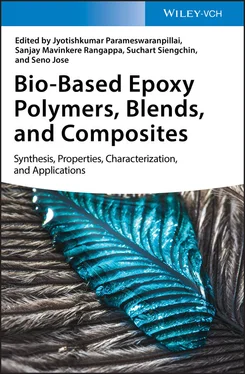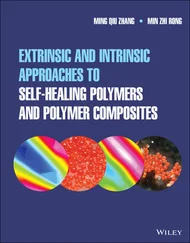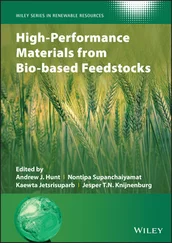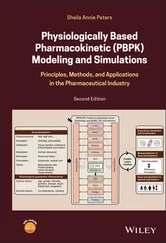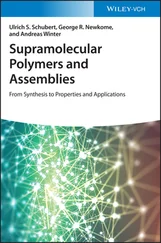1 Cover
2 Title Page Bio-Based Epoxy Polymers, Blends, and Composites Synthesis, Properties, Characterization, and Applications Edited by Jyotishkumar Parameswaranpillai Sanjay Mavinkere Rangappa Suchart Siengchin Seno Jose
3 Copyright
4 Dedication
5 Preface
6 About the Authors
7 1 Synthesis of Bio‐Based Epoxy Resins 1.1 Introduction 1.2 Plant Oil Bio‐Based Epoxy Resins 1.3 Substitutes for Bisphenol A Replacement 1.4 Bio‐Based Epoxy Curing Agents References
8 2 Natural/Synthetic Fiber‐Reinforced Bioepoxy Composites 2.1 Introduction 2.2 Synthetic and Natural Fibers 2.3 Bioepoxy 2.4 Fiber‐Reinforced Bioepoxy Composites 2.5 Future Perspectives 2.6 Conclusions Acknowledgments References
9 3 Polymer Blends Based on Bioepoxy Polymers 3.1 Introduction 3.2 Plant Oils 3.3 Preparation of Bioepoxy Polymer Blends with Epoxy Resins 3.4 Application of Bioepoxy Polymer Blends 3.5 Conclusion References
10 4 Cure Kinetics of Bio‐epoxy Polymers, Their Blends, and Composites 4.1 Introduction 4.2 Fundamentals of Curing Reaction Kinetics 4.3 Curing of Bio‐thermosets 4.4 Curing Kinetics of Bio‐epoxies and Blends 4.5 Case Study: Non‐isothermal Kinetics of Plant Oil–Epoxy–Clay Composite 4.6 Conclusion and Future Prospective References
11 5 Rheology of Bioepoxy Polymers, Their Blends, and Composites 5.1 Introduction 5.2 Rheology of Bioepoxy‐Based Polymers 5.3 Rheology of Bioepoxy‐Based Composites 5.4 Rheology of Bioepoxy‐Based Blends 5.5 Conclusions and Future Scope References
12 6 Dynamical Mechanical Thermal Analysis of Bioepoxy Polymers, Their Blends, and Composites 6.1 Focus 6.2 Bioepoxies and Reinforcers 6.3 Dynamic Mechanical Analysis and Polymer Dynamics 6.4 Applications 6.5 Conclusion References
13 7 Mechanical Properties of Bioepoxy Polymers, Their Blends, and Composites 7.1 Introduction 7.2 Mechanical Properties of Bioepoxy Polymers 7.3 Blends of Bioepoxy Resin 7.4 Bioepoxy‐Based Composites 7.5 Conclusion 7.6 Future Perspectives and Recommendations Acknowledgment References
14 8 Bio‐epoxy Polymer, Blends and Composites Derived Utilitarian Electrical, Magnetic and Optical Properties 8.1 Introduction 8.2 Significance of Bioepoxy‐Based Materials 8.3 Bioepoxy‐Derived Utilitarian Electrical, Magnetic, and Optical Properties 8.4 Conclusion References
15 9 Spectroscopy and Other Miscellaneous Techniques for the Characterization of Bio‐epoxy Polymers, Their Blends, and Composites 9.1 Introduction 9.2 Various Methods for Epoxy Polymer Characterization 9.3 Various Bio‐Based Epoxy Polymers, Theirs Uses, and Methods of Characterization in Review References
16 10 Flame Retardancy of Bioepoxy Polymers, Their Blends, and Composites 10.1 Introduction 10.2 Methods for Analyzing Flame‐Retardant Properties 10.3 Halogen‐Free Flame‐Retardant Market 10.4 Bioepoxy Polymers with Flame‐Retardant Properties 10.5 Use of Fillers for Improving Flame‐Retardant Properties of Bioepoxy Polymers 10.6 Conclusion Acknowledgment References
17 11 Water Sorption and Solvent Sorption of Bio‐epoxy Polymers, Their Blends, and Composites 11.1 Introduction 11.2 Bio‐epoxy Resins 11.3 Conclusion References
18 12 Biobased Epoxy: Applications in Mendable and Reprocessable Thermosets, Pressure‐Sensitive Adhesives and Thermosetting Foams 12.1 Introduction 12.2 Mendable and Reprocessable Biobased Epoxy Polymers 12.3 Pressure‐Sensitive Adhesives (PSAs) From Biobased Epoxy Building Blocks 12.4 Biobased Epoxy Foams References
19 Index
20 End User License Agreement
1 Chapter 1 Table 1.1 The content of various fatty acids in selected vegetable oils. Table 1.2 Proportions of interunit linkages in softwood and hardwood 50. Table 1.3 Thermal analysis data for epoxy resin blends containing DGEBA and c... Table 1.4 Thermal decomposition of BPA‐based epoxy resin and the DGEBA/lignin... Table 1.5 Thermal and mechanical properties of PTCP, neat epoxy, and EP/PTCP ... Table 1.6 TGA, T g, and T dvalues of epoxy resin samples cured with different c... Table 1.7 Properties of epoxy resin networks cured with bio‐based curing agen...
2 Chapter 2 Table 2.1 Some commercial aramid fibers [9]. Table 2.2 Typical melting temperature ranges of PE [17-19]. Table 2.3 Composition ranges (%) and applications for commercial glass fibers...Table 2.4 Compiled properties and chemical compositions of natural fibers [56...Table 2.5 Mechanical and physical properties of two types of silk fibers [79,...Table 2.6 Mechanical and physical properties of basalt fiber [92].Table 2.7 Price of several fibers [95].Table 2.8 Mechanical properties of epoxidized natural oil.Table 2.9 Comparison of the bio‐based DGEI with the petroleum‐based DGEBA wit...Table 2.10 Comparison of Epidian 5 DGEBA and isosorbide‐based epoxy with four...Table 2.11 Tensile and fracture properties of furan‐based epoxy compared with...Table 2.12 Flexural strength of polyphenolic epoxy compared with DGEBA [115].Table 2.13 Comparison of mechanical propertie of polyphenolic epoxy and DGEBA...Table 2.14 Impact properties of ENR‐modified DGEBA [118].Table 2.15 Thermal properties of epoxidized lignin and DEGBA [121].Table 2.16 Tensile properties of vanillin‐derived epoxy [122].Table 2.17 Flexural properties of DGEDVCP [123].Table 2.18 Flexural and impact properties of rosin‐based resin [125–128].Table 2.19 Tensile properties of bioepoxy with different ratios of FPR and EG...Table 2.20 Mechanical properties of glass fiber‐reinforced CSE‐modified epoxy...Table 2.21 Tensile properties of carbon and glass fiber‐reinforced bioepoxy [...Table 2.22 Mechanical properties of flax fiber‐reinforced flaxseed oil based ...Table 2.23 Comparison of hemp, ramie, and flax for cardanol‐modified epoxy [1...
3 Chapter 3Table 3.1 The fatty acid distribution of numerous common plant oils [34].
4 Chapter 4Table 4.1 List of cross‐linkers used to cure bio‐thermosets.Table 4.2 Literature summary on curing kinetics of bio‐epoxy and blends.Table 4.3 The kinetic parameters of the curing systems by non‐isothermal meth...
5 Chapter 5Table 5.1 Gel time data for the reactive systems DGEBA/IPD, DGEDAS n/IPD, and ...Table 5.2 Epoxy resins produced from rosin.Table 5.3 Gel time data of the hybrid resins at various temperatures (mean da...
6 Chapter 7Table 7.1 Mechanical properties of bioepoxy polymers.Table 7.2 Tensile and flexural properties of bioepoxy blend systems.Table 7.3 Tensile strength and modulus properties of bioepoxy‐based composite...Table 7.4 Mechanical properties of bioepoxy‐based nanocomposites.Table 7.5 The improvements attained on the properties of bioepoxy‐based nanoc...
7 Chapter 8Table 8.1 Electrical and electronic properties, method of epoxy casting techn...Table 8.2 Electrical systems, method of epoxy casting technique, and methodol...
8 Chapter 9Table 9.1 Typical bands in the IR spectra.Table 9.2 Sample of electronegativity effects and chemical shift.
9 Chapter 10Table 10.1 The oxygen index of representative plastics.Table 10.2 UL‐94 rating.Table 10.3 CFT factors with variation of polymer molecular structures.
10 Chapter 12Table 12.1 Detailed data from microcombustion calorimetry of the PSA.
1 Chapter 1 Figure 1.1 Schematic structure of triglycerides. Figure 1.2 The reaction of triglyceride epoxidation with organic peracids. Figure 1.3 Chemical structure of cationic photoinitiators. Figure 1.4 The synthesis of high‐molecular‐weight epoxy resins based on modi... Figure 1.5 Cross‐linking reactions of epoxy fusion process products. Figure 1.6 Chemical structure of the cycloaliphatic resin (3,4‐epoxycyclohex... Figure 1.7 Triarylsulfonium salts applied as the cationic photoinitiators. Figure 1.8 Structure of vernolic acid methyl ester and product of its reacti... Figure 1.9 Structure of norbornyl epoxidized linseed oil. Figure 1.10 Structure of epoxidized cyclohexene‐derivatized linseed oil. Figure 1.11 Simplified structure of softwood lignin (including three monolig... Figure 1.12 Summary of the main strategies for lignin conversion [49, 55]. Figure 1.13 Cured epoxy resins from lignin hydrogenolysis products. Figure 1.14 Synthesis of lignin‐based epoxy and epoxy asphalt. Figure 1.15 Schematic routes of lignin modification and crosslinking: (a) ep... Figure 1.16 Route of the synthesis epoxy monomers from selectively hydrodeox... Figure 1.17 Lignin modification and cross‐linking: (a) ozone oxidation of Kr... Figure 1.18 Chemical structures of (
Читать дальше
